Varsity men’s team members (l-r) Nick Patterson and Granger West, sophomores at Walton High School, Marietta, Charlie Stephens, a sophomore at Roswell High School, Roswell, and Edmund Lynch, sophomore at Walton High School, row in a four shell (four rowers with a coxswain) as they are displaying what is known as sweep rowing (each rower uses one oar). The coxswain for their boat is Morgan Griffin, a sophomore at Roswell High School. Photo By Michael Alexander
Roswell
Unique club introduces youth to intense, beautiful sport of rowing
By ANDREW NELSON, Staff Writer | Published June 23, 2016
ROSWELL—Some 150 rowers learn teamwork and persistence, along with the thrill of skimming over the water, as members of the St. Andrew Rowing Club.
Among them are two who lined up against the best at the U.S. Rowing Youth National Championships in early June, missing out on the semifinals by three seconds. Their performance was 11th fastest out of about 130 entrants.
On a sunny afternoon before the New Jersey competition, Emily Ames and Riley Kerber hauled their two needle-shaped sculling shells into the flowing, tree-lined Chattahoochee River.
The teenagers, with sculptured shoulders and the V-shaped back of athletes, timed getting their oars in and out of the water in sync.
“That’s the only thing in the world,” Kerber, 17, said about being out on the water. “That’s one of the greatest things about rowing in general. It is just away from the rest of the world.”
“You don’t have to be a star”
The St. Andrew Rowing Club is a 30-year collaboration with St. Andrew Church, on Riverside Road. On an idyllic stretch of the Chattahoochee River, part of the parish campus is set aside for the club and for Georgia Tech rowers.
The boathouse honors the former pastor who helped launch the club. Rowers from Georgia Tech had asked the parish to use the land with its riverfront access for its team. The late Msgr. Peter Ludden required university rowers to start a youth rowing program before he blessed the idea. Years later, and despite requests to expand its program, the club remains focused on the youth. Teenagers from high school seniors to middle-schoolers push off into the Chattahoochee River here.
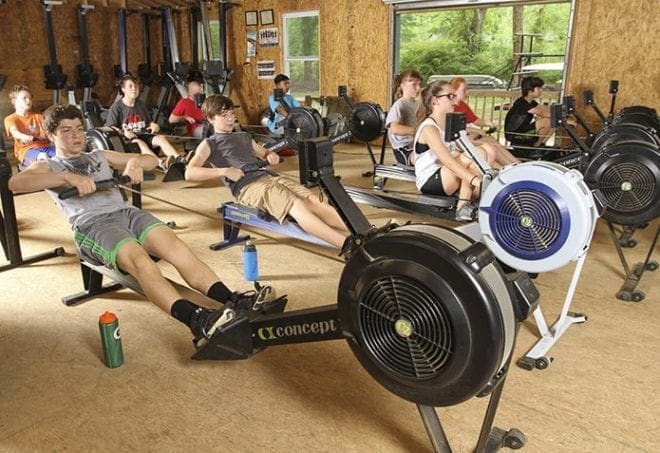
Middle school athletes work out on the ergometer, sometimes known as an ergo or erg machine. In addition to being a conditioning tool, the machine simulates actual rowing strokes and it allows the athletes to go through different parts of strokes at various increments. Photo By Michael Alexander
The property houses several buildings, including a large training shed full of ergometers where rowers warm up and practice oar technique.
“It’s a lot of responsibility, but it’s a lot of teamwork and camaraderie. There’s no prerequisite, just a desire to learn the sport. We encourage all kids,” said club co-president Rudy Tanasijevich.
There are four squads at the club—novice boys and girls and varsity boys and girls. A middle school program prepares kids for rowing too, with no experience necessary.
“You don’t have to be a star. It’s sort of a clean slate for everybody,” Tanasijevich said.
The club is welcoming newcomers to try the sport. A learn-to-row camp is being offered this summer, beginning June 20. The weekly camp sessions are offered in June and several weeks in July with morning, evening and all-day programs. Interested youth can attend more than one week. The goal is to introduce the sport to teenagers, having them power a boat on the river in unison with other rowers.
“We want them exercising”
Coach Jason Berric said the club’s goal is that every student tastes success, not just the top rowers. The coach said he wants the highest number of students possible rowing at their top performance, not just to focus on the top students.
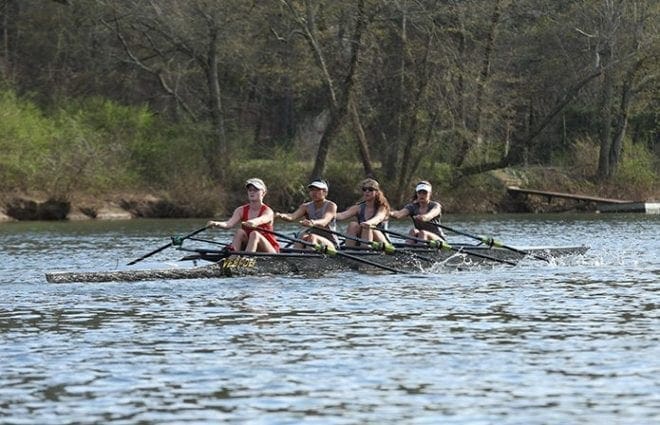
Varsity women’s team participants (l-r) Kenzie Fisher, a junior at Riverwood High School, Atlanta, Laura Nelson, a sophomore at Centennial High School, Roswell, Isabel Castro, a freshman at South Forsyth High School, Cumming, and Madison Barber, a senior at the Westminster School, Atlanta, row on the Chattahoochee River in Roswell. In their quad shell (four rowers and no coxswain) they are displaying a type of rowing called sculling (each rower uses two oars). Photo By Michael Alexander
Debbie Parker, who rowed on the U.S. national team in the late 1980s before starting a family, is the middle school coach.
The club accepts everyone, no matter the skill level, she said. If the teen isn’t a super athlete, there is room still on a boat, she said. In addition to teaching rowing, Parker said there are life lessons.
“We try to make sure they get along, respect each other, respect the coaches. Even when you don’t get out (on the water), we want them to get used to working together. We want them exercising,” she said.
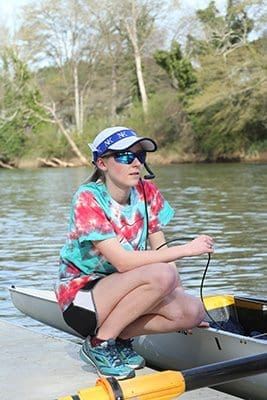
Sarah Leftwich, a senior at Centennial High School, Roswell, has been a coxswain for the varsity men’s team for four years. Her 16-year-old sister, Julia, rows on the varsity girl’s team. Photo By Michael Alexander
Parker, a longtime member of St. Andrew Church, had three children go through the club. The club prides itself on being a family, no matter a child’s talent.
“There’s more to it than just competition. There’s a family attitude to it,” she said.
Athletes are required to participate in community projects. About a dozen parish families have young people participating in the rowing club, she said.
Ames and Kerber started a recent practice on sliding ergometers to simulate being on the water. The duo matched the quick pace before giving the drill an extra boost of speed as they snapped down their knees and strained with their backs and arms to pull in the handles.
Throughout the years of training, Kerber created a mantra that keeps her focused when her energy is drained: “Feeling good, looking good, oughta be in Hollywood.”
“It’s such a graceful sport”
This fall, along with fellow St. Andrew Rowing Club member Gillian Burns, Kerber will be rowing for the University of Louisville, Kentucky, team. The senior from Walton High School, in Marietta, was drawn to the sport while watching rowers. She helped at regattas when her older brother was in the club.
“I saw all the girls. They looked so tough,” she said, with a smile.
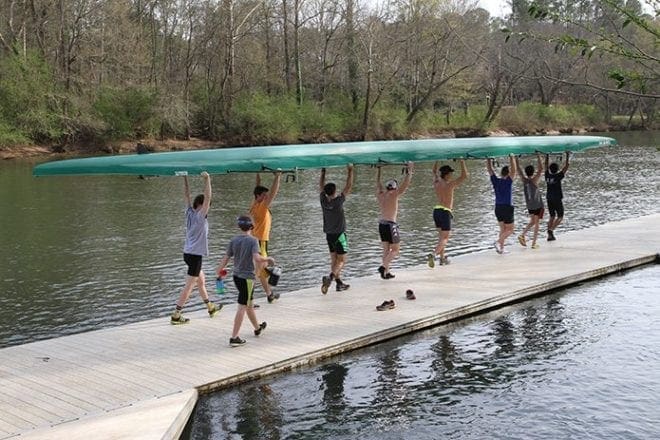
Members of the St. Andrew Rowing Club varsity men’s crew team carry an eight-man boat to the dock on the Chattahoochee River in Roswell. Photo By Michael Alexander
When she was old enough, in eighth grade, she joined. The club became a second home.
“You have your family to work with you,” she said. “It’s worth it in the end. There are days you don’t want to do any work, but you do it. It makes you stronger. It’s very much worth it in the end,” said Kerber.
As a sophomore at Walton, Ames, 16, was making her first trip to nationals. She quit basketball after she watched a rowing practice. “It looked so intense, and it was so different than any other sport that I played.”
Her strength in the boat is speed, quickly getting an oar in and out of the water to propel the boat.
“I wanted to prove I could be as fast as they are,” she said about rowing with veteran members. When she isn’t here, Ames is a member of her high school Latin and business clubs.
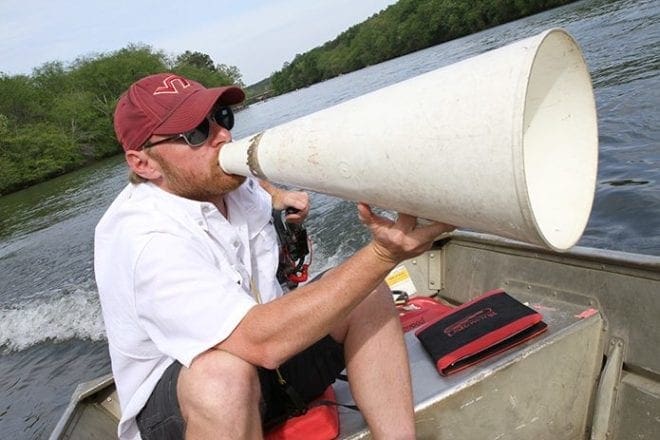
Varsity men’s coach Nick Johnson, an alumnus of Virginia Tech, shouts out commands to rowers from the stern of the coach launch boat. Johnson, a native of Alexandria, Va., is in his first season of coaching at the St. Andrew Rowing Club. Photo By Michael Alexander
Stephanie Parker, 17, is one of the women’s varsity captains. She is the youngest of four Parker children and the third to row. Her sisters went on to compete in college. She’s been in the club since eighth grade, giving up soccer. Before joining the club, she volunteered at regattas, often holding boats at the starting line.
“Watching the starts and the intensity of rowing made it really intriguing,” she said. “It’s such a graceful sport.”
Payton Fisher, 17, is a five-year veteran of the club. She attends Riverwood International Charter School, in Sandy Springs. Fisher, the second women’s captain, said the club works best when all its members, from the weakest rower to the strongest, build up the team.
“We have been taught that the best way to achieve greatness is to build the team up from the bottom. It’s those kids in the lower boats that are really one of the most important parts of the team because they drive the top boat to get faster as they improve themselves. This mentality at St. Andrew really is unique to this team. It makes everyone on the team, no matter what boat, feel important.”